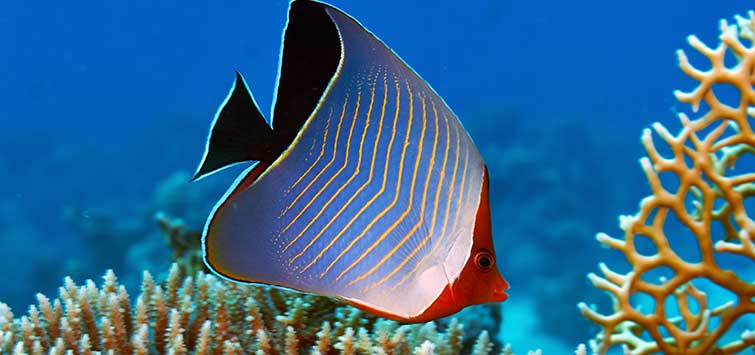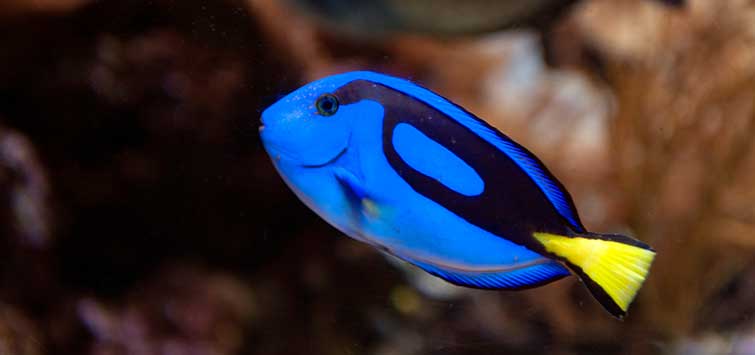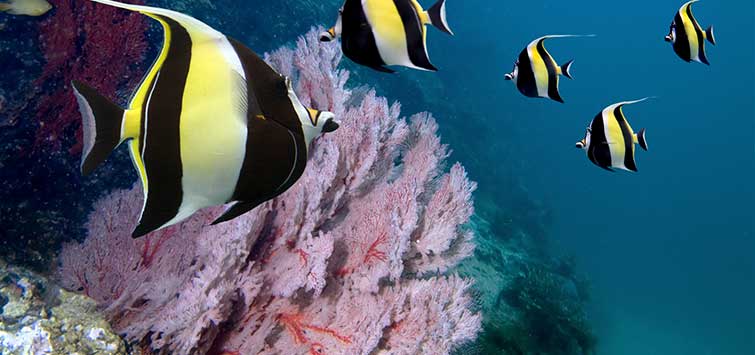The Heartbreakers
Author: Jim McDavid
When starting up a tank, it is essential to know which fish will thrive in your setup and, just as important, which ones won’t. An expert reefkeeper profiles the most commonly available species that simply never do well in captivity.
Going Belly-Up
Most aquarists have had the unfortunate experience of excitedly bringing a new fish home from the store only to have it perish within a month or two, if not much sooner. I can walk down the aisles of most fish stores and count how many such experiences await the clientele of that particular establishment in the next few weeks.
Many Choices
The choices of marine fish available at our local retailers, from various online stores, and in the many hobby books that have been published are numerous. Picking suitable residents for the marine aquarium can be an overwhelming and confusing task, especially for the beginning marine aquarist.
Some Fish Should Stay in the Ocean
The fact of the matter is that many varieties of fish collected for the hobby should simply remain in the ocean. For every live specimen of these delicate species we see for sale in a store, there are often hundreds of individuals that perish. For every one of these lucky specimens that are brought home and live for a time in captivity, scores die within a few weeks in the tanks of unwary (or unwise) keepers.
Other species do slightly better but are still relatively delicate or difficult to acclimate to captive foods. While a small number of these delicate fish acclimate and do quite well, in general, the purchase of one of these fish ends in disappointment.
Avoid Making the Wrong Choices
The answer to preventing heartbreak in your own tank is, for the most part, rather simple: Avoid purchasing the delicate species that are so often the victims of these losses.
Part of the problem is that many of the most beautiful species are also the most problematic—that’s what makes them heartbreakers! What is called for on the part of the aquarist is due diligence and restraint in equal parts. Plenty of beautiful, hardy, long-lived species are available, so there is little reason to mess with very delicate species, let alone impossible ones.
Research
The first and most important tool that will enable you to succeed is research. Know what you’re looking for and why, and simply do not make impulse fish purchases—ever! We’ve all been tempted by the beautiful fish in the store that we know absolutely nothing about. Most of us have succumbed to this type of poor judgment on one occasion or another.
The reality is that given the myriad fish available, and their varying levels of hardiness, dietary preferences, temperament, and maximum size, the likelihood is very high that you’ll end up with a fish that is completely unsuitable for your experience level, your particular setup, or captivity in general. With all the information available on the Internet, let alone the hundreds of books and magazines that have been published over the years, there is really no excuse to make an uninformed fish purchase. Online forums are also excellent resources, with plenty of hobbyists at your disposal who will be happy to share their experience with a given species.
Please be aware, however, that accounts of one or two individuals keeping a normally impossible species should not be taken as clearance to purchase the species in question! There are always exceptions, and it’s a foolish choice to purchase, for example, an obligate coral feeder in hopes that you’ll be one of the few fortunate keepers to end up with an individual that accepts frozen krill. I also must say that what follows is by no means a complete list.
Difficult Species to Keep
The Moorish Idol
An icon in and of itself, the Moorish idol (Zanclus cornutus) is, without a doubt, one of the most recognizable marine species in the world. With appearances in thousands of books and on bathroom mats, towels, rugs, kitchen accessories, and movies, it’s no surprise that they find their way into home aquariums now and then.
Unfortunately, this fish almost never survives beyond a few months in captivity. A few more might make a year, and almost none live beyond that. Moorish idols aren’t necessarily delicate or disease prone. The problem stems from their dietary requirements. Feeding in the wild on benthic invertebrates, such as tunicates and sponges, as well as assorted other critters, their diet is impossible to duplicate in captivity and they rarely adapt to captive fare. The result is that they almost always starve to death or succumb to disease stemming from malnutrition.
While a few keepers here and there have been successful in maintaining this species for a short time, we should keep in mind that the lifespan of most larger marine species is in excess of 10 years. A 1- or 2-year run you may read about on a forum is far from a success story. This goes not only with the Moorish idol, but any species mentioned in this article.
Parrotfishes
These beautiful and unusual-looking fish feed on algae that live on live and dead corals in their reef habitat. They often bite off chunks of stony coral with their powerful, beak-like jaws as they graze, and their teeth and jaws are highly adapted for this specialized feeding behavior.
The Princess parrotfish (Scarus taeniopterus) is perhaps the most commonly available parrotfish representative and is another difficult, often impossible, species to feed in captivity. Further, it is one of the species that do poorly in the confines of a home aquarium, regardless of dietary considerations.
Public aquariums that can provide ample space and the proper diet are sometimes able to maintain parrotfishes, but they will continue to be a family to steer clear of for the home aquarist. The fact that wholesalers and retailers continue to offer these fish (as with some other species mentioned in this article) is a continuing frustration and evidence of wanton irresponsibility and lack of integrity in the opinion of this author.
Hooded Butterflyfish
The hooded butterflyfish (Chaetodon larvatus) is included here to represent an entire group of coral-polyp-feeding butterflyfishes that should be avoided without exception. Extraordinarily beautiful (it’s a heartbreaker after all!), this species’ diet simply cannot be replicated in captivity. Indeed, one could argue that the most beautiful butterflyfishes are the ones that simply will not survive in home aquaria.
Aquarists who are dead set on keeping a member of this group should choose from the species that are better suited to captivity and will accept foods other than live coral polyps, such as the blackback butterflyfish (C. melannotus).It should be noted, however, that many keepers will find the reasonable choices somewhat less striking than the impossible-to-keep species. This is part of what truly makes them heartbreakers!
Rock Beauty Angelfish
From the genus Holacanthus, a group of angelfishes that are relatively resilient, comes this single deviant that is notoriously difficult to keep. An obligate sponge feeder in the wild, the rock beauty angelfish (H. tricolor) rarely adapts to captive fare. Once in a while, a rare specimen will acclimate and survive if offered a sponge-based diet, but this is by far the exception rather than the rule. Aquarists are best advised to look elsewhere if a large angel species is on the want list. The king angelfish (H. passer) is far better suited to captivity and is a genuinely hardy, not to mention gorgeous, fish.
Regal Angelfish
Another iconic species that has found its way onto many items of bathroom and kitchen decor, the regal angelfish (Pygoplites diacanthus) is also the very definition of heartbreaker. This species has lured many would-be keepers, but it suffers badly from the rigors of collection and shipping, so things generally end badly for both fish and aquarist. Perhaps the outcome would be better if one could place this species in an aquarium an hour after collection, but that, sadly, is not possible.
It also has the bad habit of not accepting captive food offerings. Specimens from the Red Sea and Indian Ocean often fare better, but even these cannot be considered hardy. An advanced keeper would be well advised to seek out a healthy specimen from the locales mentioned above, while less experienced keepers need not apply.
Multibar Angelfish
The multibar angelfish (Paracentropyge multifasciata)is another beautiful angelfish species, this time of the dwarf variety, and equally difficult as the species mentioned above. The longest I’ve personally seen this fish live in captivity is eight months, in a very large tank with a preponderance of live rock to pick at—hardly a success story! Collected from deep water and an obligate sponge feeder that almost never accepts prepared foods, here’s another fish that screams “leave me in the ocean!”
Powder Blue Surgeonfish
The powder blue surgeonfish (Acanthurus leucosternon) is a strikingly beautiful fish and a member in good standing of the heartbreakers club. The problem here is not so much feeding, although they can certainly be finicky eaters. The bigger problem is simply the delicate physical nature of the species.
With a tendency to deal poorly with the stresses of collection and shipping, many individuals perish before reaching the retail store. Their immune system is easily compromised, and partially as a result being very disease prone (even acclimated specimens are more disease prone than most other fish), most specimens do not survive long. Some fishes just do not adapt well psychologically to being confined in a small box, especially some of the surge-zone-dwelling acanthurids, such as this species and the powder brown surgeonfish (A. japonicus).
Pacific Blue Tang
Succumbing to the same weaknesses as the powder blue surgeonfish, the Pacific blue tang (Paracanthurus hepatus) makes another poor choice for the vast majority of keepers. If attempted, it should be the first fish added to the tank and no aggressive tankmates should be subsequently added.
Mandarinfish
The mandarinfish (Synchiropus splendidus) is a brilliantly beautiful, absolutely fascinating little fish that needlessly perishes in the care of many hobbyists. A benthic predator that feeds exclusively on tiny crustaceans, such as copepods and amphipods, a large amount of live rock is needed to keep up with the constant grazing of even one of these fish. Because of this fact, they generally do not survive for long in anything smaller than a well-established 100-gallon-plus tank with generous amounts of live rock.
Many aquarists see this small fish and come to the conclusion that it will live happily in a small tank—an impulse decision that ends in disaster almost 100 percent of the time. Smaller tanks simply cannot produce enough food to sustain even one of these fish, and they slowly starve.
A refugium can be helpful in providing sheltered areas for the pods to multiply without predation pressure, and the pods will then make their way into the display. Another helpful technique is to make “pod piles” behind the main body of live rock. These are simply piles of live-rock rubble, again providing sheltered areas for the mandarin’s primary food items to live and reproduce. With some planning, this is a rewarding and trouble free species—but it is not suitable for a nano tank.
I should note that this admonition applies to wild-caught mandarins, which currently represent the vast majority of specimens sold on the market. However, S. splendidus is now being bred in captivity, with the young being raised on a variety of prepared foods. These captive-bred specimens are much better suited to aquarium systems than their wild-caught counterparts and may even be appropriate for nano tanks (as the sole inhabitant), where they could easily locate offered food items. Hopefully the availability of captive-bred mandarins will continue to grow so I can eventually take this species off my list of heartbreakers.
Leopard Wrasses
The many failures suffered with the leopard wrasses are for the same reasons mentioned for the mandarinfish. The same considerations also apply with regard to tank size and live rock. As with the mandarinfish, the leopard wrasses (Macropharyngodon spp.) do best in a large reef aquarium with no other fish competing for the same, limited food source. It would, for instance, be a bad idea to stock both a mandarinfish and a leopard wrasse unless the tank is over 200 gallons, very well established, and full of live rock.
Purple Queen Anthias
Belonging to the same family as the groupers and sea basses, anthias are somewhat of an anomaly in the group with regard to hardiness. In a group of fishes that are as tough as nails, the anthias buck the trend for the most part. Even the relatively hardy representatives fall well short of the rock-solid category that we can safely place many of their cousins in.
One of the most delicate is the purple queen anthias(Pseudanthias pascalus), although more than a handful of other Pseudanthias species could easily be the focus of this section. Because this species suffers easily from shipping stress, malnutrition, and disease, careful selection is the key to success, as are maintaining pristine water conditions, providing plenty of swimming space, allocating plenty of available shelter, paying attention to nutrition, and offering plenty of water movement.
Living in harems of one male and a group of females in the wild, the less delicate species will do fine individually. However, in the case of P. pascalus, keeping a group of one male to five or so females in captivity will help mitigate stress greatly. Of course, this also increases an already risky investment!
To further complicate things, these fish need constant feedings of nutrient-dense foods, something most keepers and their tanks are unable to adequately supply. Most specimens wither away within a few months if not weeks. Most aquarists are better advised to turn their attention to hardier species, such as the Bartlett’s or lyretail anthias (Pseudanthias bartlettorum or Pseudanthias squamipinnis).
Heartbreakers of a Different Order
There are fishes that don’t eat and fishes that are just too delicate, but we have one more category of heartbreaker—those fishes that simply get too big! As with the other unsuitable fishes mentioned in this article, most keepers have no business purchasing these behemoths. Those who do are doomed to see a fish that they are possibly very fond of outgrow its quarters and perhaps cause havoc with its tankmates.
Queen Triggerfish (Balistes vetula)
Perhaps the most often purchased fish in this category is the queen triggerfish (Balistes vetula). Brilliant, beautiful, and outgoing, this is truly the queen of the family Balistidae. Unfortunately this fish not only grows too large for most home aquaria, its large size isn’t a theoretical, in-the-wild consideration—this fish grows large and grows quickly in captivity! This species grows to a maximum size of nearly 2 feet, with captive individuals easily growing to 19 inches.
Almost no aquarist is equipped to deal with this fish, especially when tankmates are considered. This is because the queen triggerfish has an attitude to match its physical proportions. Triggerfishes can be among the most aggressive and destructive of fishes even at smaller sizes, and an 18-inch queen triggerfish exists in only one possible state—alone! If size alone isn’t enough of a deterrent, then its proportions coupled with its temperament should be.
Queensland Grouper (Epinephelus lanceolatus)
Another fish that grows much too large, even for some public aquariums, unfortunately finds its way into hobbyists’ hands. The Queensland grouper (Epinephelus lanceolatus), often sold as the bumblebee grouper, gets too large to live comfortably in even a room-sized aquarium! Not only does it grow to massive proportions, it grows very quickly and can swallow fishes nearly as large as itself along the way. Obviously, nearly every aquarist on the planet, regardless of resources, should steer clear of this species.
Questionable integrity on the part of collectors, importers, and retailers even allowing the fish into the hobby is certainly the root of the problem. Now, add poor or non-existent research on the part of the aquarist, and we have yet another keeper with an animal that he or she cannot possibly deal with. The colors are absolutely stunning in this species, yellow and black stripes as youngsters, changing to an even more attractive mottled striped pattern as the fish grows into a juvenile. It is after all a heartbreaker! Given its beauty, it’s hardly surprising that unwary (or unwise) keepers bring them home.
Don’t Get Your Heart Broken
It is the hobbyist’s responsibility to make sure he or she is qualified to care for a given species before it finds its way into the home aquarium. There are fishes that are well-nigh impossible to keep and others that may require conditions that you cannot provide for space or monetary reasons. Still others may demand a level of husbandry that is beyond your capabilities. Research is the first step, and so armed, we may avoid many of the fish losses, disease outbreaks, and other frustrations that often plague so many unprepared marine hobbyists.
The good news is, there are enough hardy, easily maintained, and rewarding fish in the hobby that a heartbreak-free fish-keeping experience is easily within reach.

.png?h=595&iar=0&w=2781&hash=5FD5E69473BCC22199FBFA2FB71B6033)



